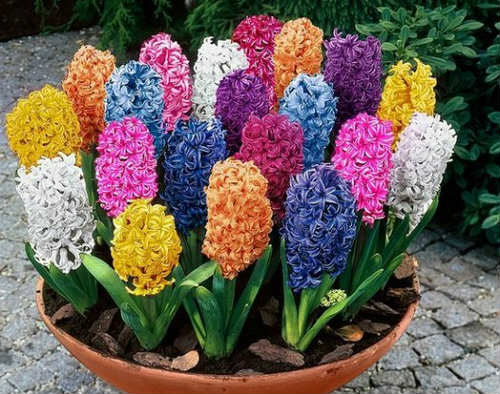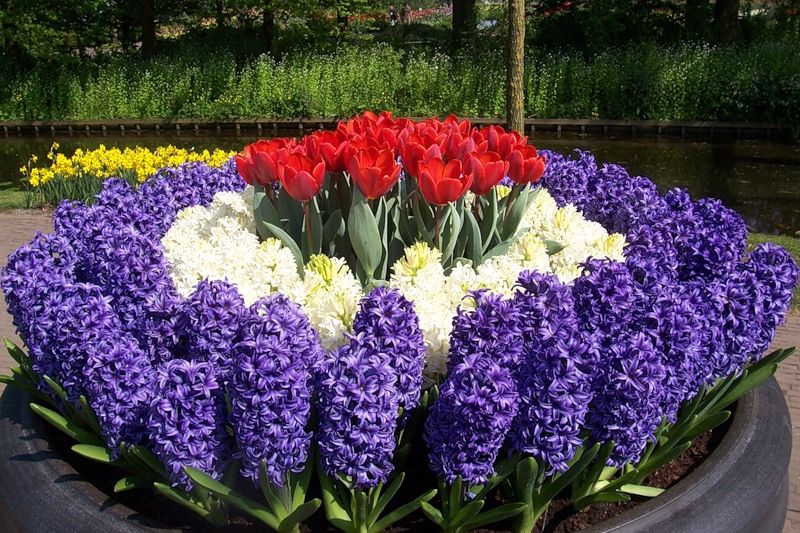Not many people know that hyacinths are not an annual plant. Many inexperienced flower growers stop caring for them after flowering. Although, this is wrong. After the flower has shed its leaves, it is necessary to cut off the legs. Well, of course, do not forget to feed and water them.
The plant sits depending on when the grower wants to see its beauty. Hyacinth is planted in spring, autumn, winter. If planting occurs in winter, then the flower is well covered so that it does not freeze. It is advisable to do this with a film. In this case, it will need to be removed early, before flowering begins.
How to plant hyacinths in open ground
The flower can also be kept at room temperature. Planting material is similar to a bulb. It can be kept in the refrigerator for the first time. When it begins to germinate, then the plant must already be pulled out of the refrigerator. For best growth in a pot, 18-20 degrees room temperature is suitable. And, of course, constant illumination.
Planting hyacinths:
- If the soil is heavy, then you can add sand.
- Dig up the ground where the landing will take place. Preferably 40 cm deep.
- Add fertilizer. They will help you grow fast. For this, superphosphate, potash fertilizers, ash, dolomite flour are suitable.
- Be sure to remove the weeds. The soil should be clean, free of foreign grass.
- Just before planting, be sure to dig up the ground again. Then fertilizers with sand evenly move.
- The presence of drainage.
- Planting a plant.
- Abundant watering.
Landing time selection
Although hyacinths can be planted at any time. But autumn is still the best. In winter, like any plant, they may not survive frosts. In the fall, they will have time to take root. When planting in the ground in autumn, the temperature should be up to 10 degrees Celsius. Hyacinths can be insulated with peat. But in the spring, when flowering begins, the peat is removed.
The flower can be kept at home for about 2 months. The first time it is placed in the refrigerator. When the first sprouts are laid, they are taken out. Then it is stored at room temperature. Moreover, the temperature should not exceed 20 degrees Celsius. Lighting should also be. Preferably all the time.
Further growth depends on additional light. So, the flower feels warmth and care. It is best to store the bulb in peat.
Site selection and soil preparation
Prepare the soil properly. It must contain organic and mineral fertilizers. Before planting, you need to add mineral and other fertilizers. Superphosphate, magnesium sulfate and potassium are well suited. It is best to add sand to clay soil. Also, hyacinths do not like airflow, draft. They do not like direct sunlight. This is especially bad for the color of the plant.
Bright buds can quickly become dull. Therefore, the shadow must be present.
Soil processing and preparation
Features of soil preparation:

- The ground must be neutral. If the ground contains more clay, then add sand. If the earth is acidic, then liming is necessary.
- Definitely drainage. It helps the water not to stagnate.
- Bright hyacinths do not like strong sunlight. They affect color. As a result, the colors cease to be bright. And besides the color, the plant is quite capricious. Therefore, he needs a periodic shadow.
- Doesn't like drafts. Best planted near trees or shrubs.
- Fresh organic fertilizers are strictly forbidden to use.
- If the plant is infected. It is dug up and burned. Otherwise, it will infect other flowers.
- Watering should be carried out to a depth of 20–25 cm. It is not worth watering often.
- Periodically loosen the earth. Remove weeds.
The process of planting in open ground
The planting itself is standard, like many plants. But each landing has its own nuances. There are many factors why an onion goes bad. All planting material should be carefully sorted out. So that there are no rotten and sick people left.
Boarding process:

- Between rows no more than 25 cm. This is quite enough for the flowers to grow without interfering with each other.
- The bed should be up to 15 cm high. Then the water will be evenly distributed and not stagnate.
- Dig up the earth to a depth of 40 cm. This will be enough.
- Apply fertilizer. For 1 square meter up to 80 grams of superphosphate, magnesium sulfate up to 15 grams and 30 grams of potassium sulfate. Instead of potassium, you can add 200 grams of wood ash. Apply nitrogen fertilizers in spring and summer.
- But the depth of landing depends on the size of the planting material. If the bulb is more than 6 cm in diameter, then 16–19 cm. If the bulb is smaller, then up to 15 cm.
- At the very bottom of the pit we pour sand up to 5–6 cm.
- Drainage. Broken brick. Lay depending on the soil.
- If the soil is dry, then water it.
Protection from harmful factors
There are a lot of harmful factors for flowers. And unfortunately, there is no getting away from them. If you take care of it incorrectly, then you can expect trouble.
The reasons can be very different:
- Wrong landing.
- Wrong landing time.
- Too much or too little fertilizer.
- Abundant and frequent watering.
- weeds.
- Elevated temperature.
- Increased humidity.
Hyacinths are prone to diseases such as bacterial rot. There is no point in fighting. The bud is covered with mucus and has an unpleasant odor. To prevent this disease from affecting all plants, it is necessary to dig up a diseased flower and burn it. Unfortunately, there is no other way to deal with this disease.
Hyacinth propagation
Initially, no one knew how to propagate a flower. All this happened in Holland.
- Landing. The onion is cut crosswise. And then they sit back in the ground. After a while, small bulbs appear.
- Division. The bulb should be medium in size. The mother bulb is cut into 4 parts and planted in the ground. No more than 4 babies can appear in a year. In the summer, the babies are separated from the mother. But flowering will begin no earlier than in 2-3 years.
- seed reproduction. Not very common. Blooms no earlier than 6 years.
If you take care of the hyacinth in time, then it will certainly please the grower with its bright flowers.
Popular types of hyacinths
- Oriental hyacinth. It has a strong and pleasant smell. The wild species grows in Turkey and Siberia.
- Litvinov. Grows up to 25 cm. Production of Turkmenistan and Iran.
- Transcaspian. Growth up to 20 cm. With 4-10 flowers. Grows in the mountains of Turkmenistan.
- endorsement. Growth up to 25 cm. Occurred in 1863.
- Edelweiss. Up to 25 cm.
- Lady Derby. Has 37 flowers. Occurred in Holland in 1875.
- Marconi. With a purple tint.
- Bismarck. High up to 30 cm. Manufactured in Germany.



